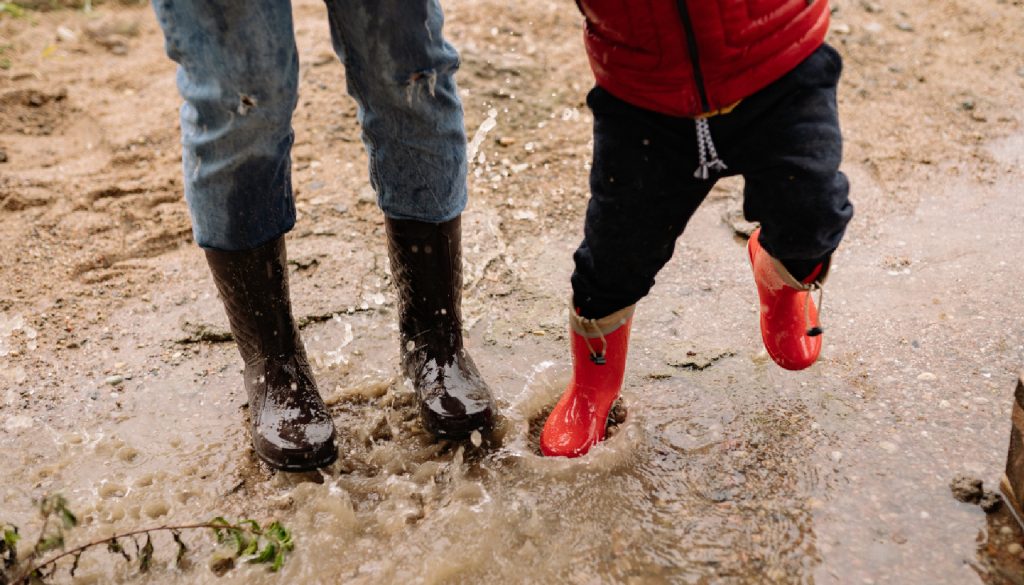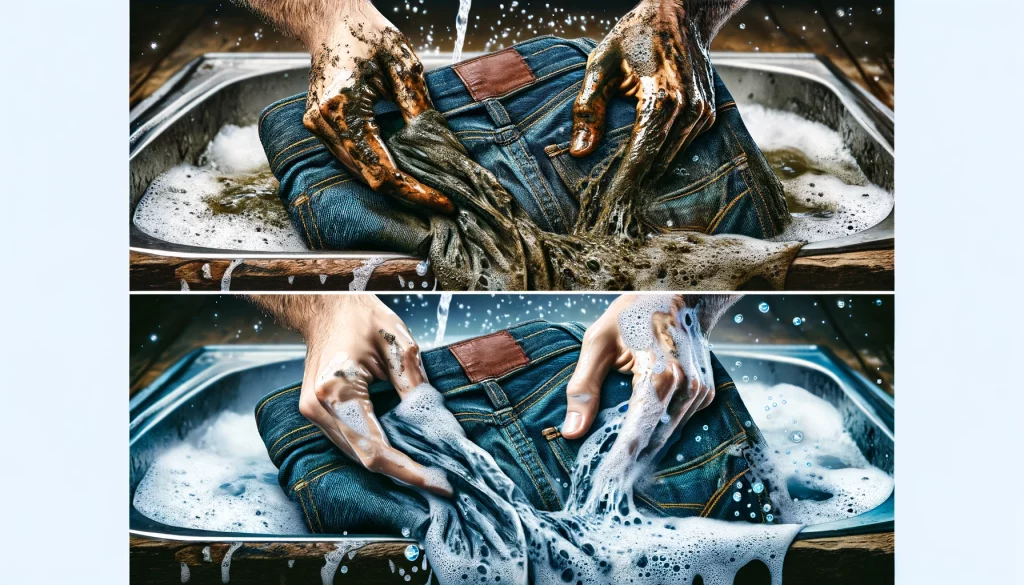Revive your wardrobe with ease by mastering the art of mud stain removal, transforming your clothes from soiled to spotless. With our expert tips and a little patience, those pesky stains will be a thing of the past, allowing you to flaunt your favorite outfits once again. For more fashion insights and quality apparel, visit inktasticmerch.com.
When mud splatters on your favorite outfit, a delightful outing can quickly devolve into a laundry dilemma. These stubborn stains are commonplace, yet they often demand more than just a basic wash to vanish. Our comprehensive guide will lead you through the intricacies of purging mud from clothes and textiles, enabling you to effortlessly restore their original condition. Read on for impeccable results!
Key Takeaways
- It’s simpler to eliminate dry mud from clothing—let stains dry before brushing away excess and washing.
- Conquer stubborn mud spots with a powder detergent and water paste, applying directly before laundering.
- Opt for enzyme-based or robust laundry detergents to effectively disband persistent mud residue.
- Natural solutions like vinegar or baking soda can combat any remaining odors linked with mud stains.
- After pretreatment, always launder with warm water if feasible and inspect for residual stains before drying.
How to Remove Mud Stains From Clothing

Confronting mud-stained fabrics might seem daunting, yet fear not—there’s an effective method to tackle these tenacious spots. Discover the secrets for immaculate attire as we guide you through the necessary steps to effectively eradicate those gritty marks from your garments.
Let the Mud Dry
Resist the temptation to attack damp mud stains on your attire. While it might feel counterproductive, waiting for the mud to dry completely eases its removal.
Though it may seem unpleasant, initiating fabric care with patience ensures that dirt doesn’t embed deeper into the fibers, setting the stage for a more successful stain elimination process.
Once the mud is thoroughly dried, gently scrape off the excess with a dull knife or spoon. This strategy preserves delicate fabrics and primes them for an efficient spot treatment using specially formulated tough dirt laundry detergents.
Patience proves rewarding in stain removal—dried mud detaches more cleanly, leaving fewer marks after a regular wash cycle.
Scrape or Vacuum the Stain
Post drying, the mud is ready for extraction. Carefully scrape away as much of the dried residue using a dull knife or spoon edge, facilitating bulk removal without embedding it further into the material.
If accessible, using a vacuum attachment can also capture any remaining loose debris, ensuring minimal soil before pretreatment begins.
Next, concoct a paste with powdered detergent and water; apply directly to the residuals. This technique is especially effective as it addresses the persistent grime at its core.
The paste disintegrates any obstinate particles still gripping onto fibers, ensuring they are easily rinsed during the wash cycle.
Pretreat and Wash With High-Performance Detergent
While mud stains can be relentless, the right approach and products can significantly ease their removal. A potent enzyme-based detergent can tackle even the most stubborn dirt stains on garments.
- Select a trustworthy enzyme-based cleanser or a suitable heavy-duty fabric cleaner for your specific material.
- Ensure all mud has dried entirely before proceeding with pretreatment.
- When the mud has dried, gently scrape away any excess from the fabric or use a vacuum attachment to lift particles without embedding them deeper.
- Apply a small amount of high-performance laundry detergent directly onto the stain, ensuring it is fully covered for optimal penetration.
- Use a soft-bristled brush or cloth to gently work the detergent into the stain, ensuring maximum contact between the cleaner and the mark.
- Allow the detergent to sit for a minimum of 5 minutes to give the enzymes time to break down the dirt and grime.
- Wash the garment following care instructions, incorporating a potent dirt remover into the washing cycle.
- If fabric care guidelines allow, opt for warm water as it is more effective at dissolving stubborn stains than cold water.
- Inspect the garment post-wash for any remaining mud; if required, repeat pretreatment and washing steps before drying.
attempting any cleaning, allowing for easier removal without smudging.
Wash and Dry
Once the stain is pretreated, proceed to the washing machine. For optimal mud stain removal, choose warm water and a powerful detergent. Be sure to select a cycle that matches the fabric’s care label directions to prevent damage.
Check the stained area once the wash is complete. If remnants of mud persist, repeat the treatment rather than drying—the heat can lock stains into the fabric, complicating future attempts at removal.
Only when the mud is completely gone should you dry your garment, whether by air or a tumble dryer, according to the care guidelines.
Tips for Handling Mud Stains

When dealing with persistent mud stains, a few smart techniques can simplify the cleaning task; keep reading to discover these transformative methods.
Perform a Sniff Test
After handling a mud stain, always perform a sniff test to detect any lingering odor. This step is vital as your nose can pick up if the smell has settled in the fabric, flagging if further cleaning is needed.
If you catch an earthy or musty aroma post-wash, it might be time for more odor-eliminating strategies.
Trust your sense of smell as it effectively detects odors and helps remove mud from clothing. A fresh scent signals success in treating the stain and any underlying odors that might be trapped in the fibers.
If there’s still a trace of dampness or dirtiness, consider applying specialized solutions like vinegar or baking soda before sending them back to the laundry.
Apply a Vinegar Solution if Odor Persists
If stubborn odors remain despite cleaning, vinegar can be a powerful ally. This natural remedy effectively tackles persistent smells within fabric fibers.
Create a simple solution by adding 5 cups of vinegar directly into your washing machine with the clothes. Beyond its culinary uses, vinegar disarms odors and refreshes without harsh chemicals.
Wash the load as usual, allowing vinegar’s acidic properties to eliminate mildew and tenacious odors from your clothes. Post-wash, proceed with drying and enjoy the newfound freshness.
Should odors remain stubborn, consider employing more specialized treatments before another round in the wash.
If odor persists, consider additional targeted treatments.
Use Baking Soda for More Stubborn Odors
For Especially resistant smells, baking soda can complement vinegar’s deodorizing power.
With the pristine laundry in order, it’s time to conquer those stubborn stains. Start by sprinkling some baking soda over them before launching into another wash cycle.
Sprinkle Baking Soda
After battling lingering odors with vinegar, baking soda comes to the rescue for an added burst of freshness. For a natural solution that also neutralizes persistent smells, directly sprinkle baking soda onto mud stains.
This all-purpose household item does wonders by soaking up unwanted odors and dislodging dirt clinging to your clothes.
To specifically target tough mud spots, mix baking soda with water to form a paste. Gently massage this mixture into the fabric, helping to lift dirt out of the fibers without relying on harsh chemicals.
If you’re dealing with a particularly tough stain, let the mixture sit overnight before washing. Baking soda’s gentle yet powerful cleaning properties ensure that your clothes emerge both looking and smelling splendid after laundry day.
Launder as Usual
After treating mud stains with baking soda, proceed with your usual laundry routine. If your treated garment suits the load’s fabric type and colors, toss it in with other clothes.
Select a heavy-duty laundry detergent that’s renowned for tackling tough spots, aiding in the breakdown of any dirt particles left in the fabric. Use the warmest water suitable for the garment to enhance cleaning efficiency.
Set your washer cycle to achieve enough agitation to whisk away grime without harming your garments. Thanks to modern high-performance detergents and efficient washers, a regular cycle can often restore clothes tarnished by mud stains to their original splendor.
Avoid overloading your machine—allowing your clothes enough room ensures each piece receives optimal treatment during the wash cycle.
Additional Tips for Removing Mud Stains

While the steps above offer a solid strategy for tackling mud stains, a few extra tips can further bolster your stain-removal skill set, ensuring even the most tenacious mud can’t withstand your laundry prowess.
Soak in Detergent Before Washing
Give persistent mud stains a good soaking in warm, soapy water. Mix your powdered detergent into a tub of warm water, creating a robust pre-treatment solution.
Submerge your soiled clothing, allowing it to soak for at least an hour before moving on. This additional soaking time permits the detergent to deeply penetrate the fibers, helping to dislodge the embedded dirt.
Once soaked, use an old toothbrush or soft-bristled brush to gently work the suds into remaining grime spots. Choose an enzyme-rich detergent, as these enzymes excel at breaking down complex stains like mud.
Your clothes will come out looking refreshed after machine washing, thanks to this thorough pre-wash care—they’ll stay vibrant and spotless!
Use Heavy-Duty Laundry Detergent
When mud stains prove particularly stubborn, a heavy-duty laundry detergent can become your strongest ally. Apply a tough stain remover directly onto the dry dirt spots.
Gently work this potent solution into the fabric to begin breaking down even the most stubborn marks.
most persistent grime.
Start by taking a damp toothbrush, adding a few drops of water, and carefully scrubbing the potent detergent into each tarnished area. This vigorous cleaner is designed to penetrate deeply into the fibers, ensuring that remnants of outdoor fun or gardening do not stick around after washing.
Allow Mud Stains to Dry Before Washing
Delaying the cleansing of mud stains might feel counterintuitive, but it’s a deliberate tactic. This method prevents the muddy residue from embedding further into the fabric during cleaning. After your outside escapades leave your clothes muddied, resist the temptation to wash them right away.
Letting the dirt and mud settle actually aids in the process. Once these obstinate blemishes have fully dried, gently brush off the loose dirt—this sets the stage for a more effective wash later. Believe in the process of letting mud spots set before washing; it’s not about neglect, but about allowing nature to assist with the heavy lifting.
So, give those grimy jerseys or pants a break until they’re ready for a proper wash cycle.
Conclusion
Bid farewell to those tenacious mud marks on your cherished apparel. Armed with these uncomplicated strategies and efficient cleaning techniques, you have everything you need for pristine garments.
Remember that prompt care and the right methods can significantly affect your laundry results. Now venture forward and relish in life’s messy moments without fretting over the cleanup!
FAQs
1. What’s the initial step for removing mud from clothes?
Allow the mud to dry completely, then remove as much as possible by brushing it off before washing.
2. Is regular detergent effective for mud stains?
Yes, regular detergent can be used with cold water for the first wash.
3. Should I scrub the stained spot immediately?
No, avoid immediate scrubbing; instead, soak the clothing after brushing off dry mud and launder as usual.
4. Is it advisable to dry muddy clothes in the dryer?
Avoid placing muddy clothes in the dryer until the stain is entirely removed, or it might become permanent.
5. Can vinegar aid in removing tough mud stains?
Vinegar might be useful on stubborn stains; apply directly to the area and launder as usual after soaking.
For more tips and tricks on keeping your wardrobe immaculate and embracing life’s messy moments, explore our Blog for a wealth of helpful content and expert advice.




